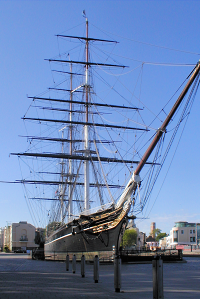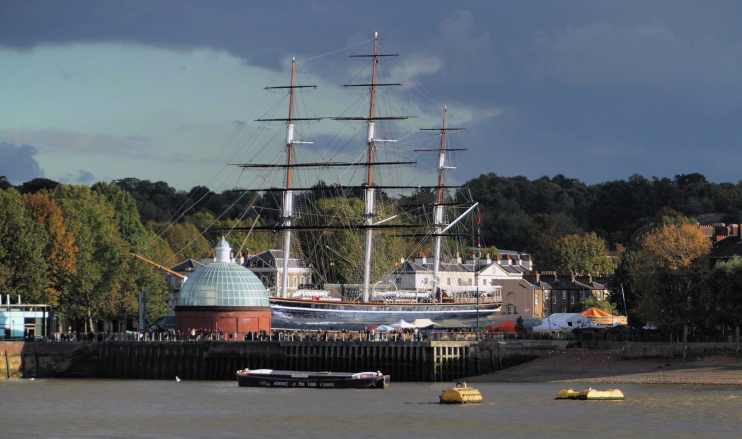Cutty Sark
“Weel done, Cutty Sark!”
Cutty Sark, Greenwich riverside

Built in Dumbarton in 1869, the Cutty Sark weighs 963 tonnes, has a 152-foot main mast and boasted a top speed of 17 knots. This famous clipper made record-breaking voyages bringing tea from China and wool from Australia back to Britain.
The ship’s name – and the inspiration for its figurehead – comes from a Scottish legend, retold by Robert Burns, of Tam O’Shanter’s admiration for a graceful young witch who wore a ‘cutty sark’, the dialect term for a short chemise.
Her cutty-sark, o’ Paisley harn
That while a lassie she had worn,
In longitude tho’ sorely scanty,
It was her best, and she was vauntie, –
Ah! little ken’d thy reverend grannie,
That sark she coft for he wee Nannie,
Wi’ twa pund Scots, (’twas a’ her riches),
Wad ever grac’d a dance of witches!*
In 1895 the clipper was renamed the Ferreira and transported goods between Portugal and its empire until 1922, when it was bought by Wilfred Dowman, a retired windjammer skipper. Dowman restored the Cutty Sark’s original appearance – and its name – and put it into service as a naval cadet training vessel.
After featuring as a showpiece at the Festival of Britain, the ship was preserved for posterity by the Cutty Sark Society, under the patronage of Prince Philip, Duke of Edinburgh. The Cutty Sark was brought to Greenwich in 1954 and opened to the public three years later by Elizabeth II.
Cutty Sark station opened on the Docklands Light Railway in 1999. The original plan for the DLR extension to Lewisham did not include a station here, but its potential convenience for tourists prompted key local institutions to help fund the construction costs.
In 2006 the ship was deemed to be ‘structurally in danger’ and the attraction was closed to permit extensive conservation work to be done. A year into this project a fire broke out on board, caused by an industrial vacuum cleaner that had been left switched on for two days. The ship’s masts, saloon and deckhouses had been removed and put into storage before the fire but repairing the damage nevertheless added considerable time and cost to the restoration programme.
Reopened in May 2012 – with the Queen again doing the honours – the Cutty Sark has been raised about eight feet higher than shown in the pre-fire photograph above, supported by canted steel props that are enclosed in a glass surround resembling a crystal cushion.
The project cost £50 million and it is hoped that no further large-scale preservation work will be needed for another 50 years.
Because the vessel has been lifted up, visitors can walk beneath the Cutty Sark as well as go on board, stroll the decks and learn about its history in the museum, which now boasts the obligatory ‘interactive features’.
Some critics were not impressed by aspects of the restoration, with the director of the Victorian Society claiming that it panders to the “corporate hospitality market” and Building Design awarding it the (derogatory) Carbuncle Cup, complaining that “from street level, the once thrilling lines of the ship’s stern and prow have now been obscured behind the new glass enclosure.” Nevertheless, in the first year after reopening, custodians Royal Museums Greenwich reported that more than 350,000 visitors had toured the attraction, a 150 per cent increase on pre-closure attendances.


